 |
 |
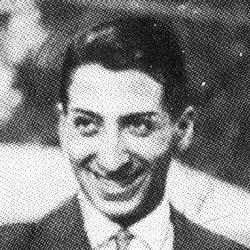 |
"The Crocodile" or "The Alligator" (2 July 1904, 12 October 1996)
|
|
|
|
|
|
|
|
|
|
and inventor |

1926
|
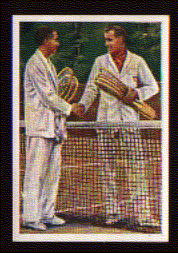
1929 with Tilden |
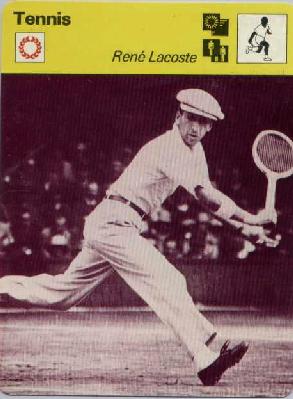
1972 |
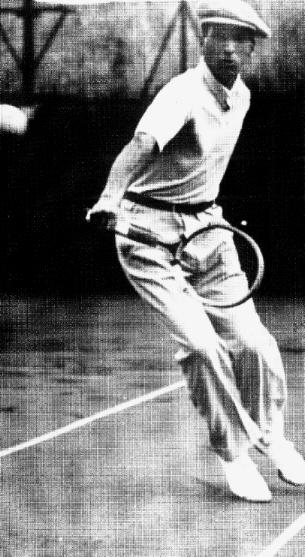 |
The
beginnings: Not everyone has such an understanding father as
the young René Lacoste, who agreed to his son giving up preparing
for the Polytechnique (one of the most prestigious engineering schools
in France) to concentrate solely on tennis. In 1922, in the amateur era,
it was a risky gamble, and his son’s future did not look very secure, but
Mr Lacoste Senior was the manager of the Hispano-Suiza factories and did
not have too many financial problems, so gave his son a year to show what
he was capable of! The young René would far exceed his father’s
expectations... he was imaginative and a shrewd businessman who brought
us the ball throwing machine (1927), the shirt that bears his name (1933),
the anti-vibration pad (1960) and the metal racket (1963).
Unlike his colleagues Borotra and Cochet, talented self-taught players who used their natural qualities by inventing most of their shots, René Lacoste secured the services of a renowned coach, Darsonval, and worked relentlessly at his game. He did not appear to have any of the natural qualities that made the players of his era, but he had his admiration for Suzanne Lenglen, a passion for the game and an almost obsessive desire to train. He was the first tennis player to include bodybuilding, running and skipping in his training. He spent hours hitting the ball against the walls of his family home (which had to be resurfaced every year). In response to his coach who criticised him for training too much, he invented a ball throwing machine! With these methods, which were modern for the time, his concentration, clear-headedness and consistency, he was to make fast progress: taking part in the world clay-court championships in 1922 and being selected for the Davis Cup for the first time in 1923, at the age of eighteen. |
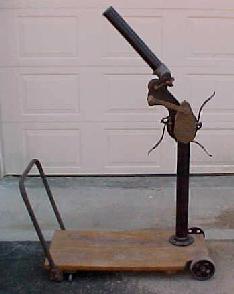
Prototype of the first ball throwing machine |
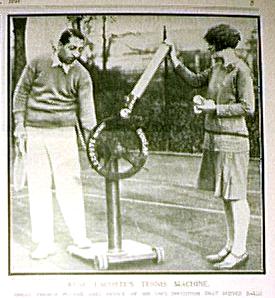
Photo from an Australian newspaper of that era. René Lacoste presents his invention. |
| His
first successes: He quickly became a pillar of the French team
and a regular on trips to America for the inter-zone finals of the Davis
Cup. He reached the final of the French championships in 1924, beaten by
Borotra, and became French No. 1 the following year, winning the first
French internationals one after the other and one month later, Wimbledon.
Partnered with Borotra, with whom he formed a remarkable team, he also
took the two doubles titles, thus achieving a European grand-slam in that
year.
Having been severely beaten by Patterson and Johnston at the Davis Cup at the end of the year, 1926 started badly for him, when he was beaten three sets to zero by Cochet at the French internationals. Having lost his confidence, he did not go to Wimbledon to defend his title, went back to his relentless training regime, worked on his shot technique and finally rediscovered his form. He was about to move to America when he secured his first victory against Tilden in the Davis Cup. Soon after he won his first American championship in Forest Hills and became world No. 1 along with Borotra and Cochet. |
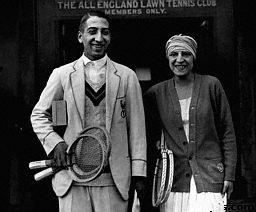
Lacoste with Suzanne Lenglen, Wimbledon, 1925
|

Second success at Forest-Hills, 1927 |
The peak: Lacoste was then at his peak and stayed there. He beat Tilden three times in 1927, thus confirming his domination of world tennis, confirmed by the Davis Cup victory, a second title at Forest Hills in 1927 and Wimbledon in 1928. In 1929, he won the Roland Garros thanks to two superb victories over Tilden and Borotra. He was only twenty-five and everyone predicted a long reign for him over world tennis.. |
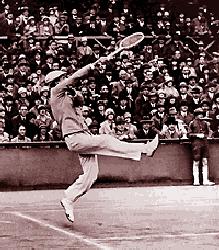 |
Against
such an opponent, only attacking players who could play very quick shots
and finish points on a volley had a chance of beating him before they were
tired out. And they had to avoid being lobbed! Cochet,
and to a lesser extent Borotra and
Tilden,
were the only players who could counter this wearing out tactic, and they
had to be on top form to do so!
This style of play, which
it could be said was invented by René Lacoste, made such a mark
on his era that his nickname "The Crocodile" became a common synonym for
returners. In general, a crocodile is boring, tenacious, with tireless
legs, appears artless, never runs unnecessarily after a ball and tries
to annoy his opponent by alternating long balls, short balls and lobs.
His shots are always slow, but he speeds them up from time to time, always
when it is not expected! Lastly, he never gets angry. However, no-one really
wants to meet one...
|
| 1963: René Lacoste
invents the first steel tennis racket: a revolution in tennis which challenged
the supremacy of the wooden racket and opened the way for today’s models.
The racket had a revolutionary round head and a “split shaft”. Its features
were a unique distribution of mass, high manoeuvrability, and an original
patented system for fixing the strings, giving better performance, particularly
with cheap synthetic strings. The racket won 46 Grand Slam titles between
1966 and 1978. Distributed in the United States by Wilson, it was used
by Jimmy Connors and Billie Jean King.
1968: Launch of a Lacoste Eau de Toilette under licence with Jean Patou. 1982: Opening of the first Lacoste boutique in Avenue Victor Hugo, Paris. Lacoste then specialised and successfully developed top of the range sports products. |
Here
is his list of grand slam achievements: 7 singles, and 3 men’s doubles.
|
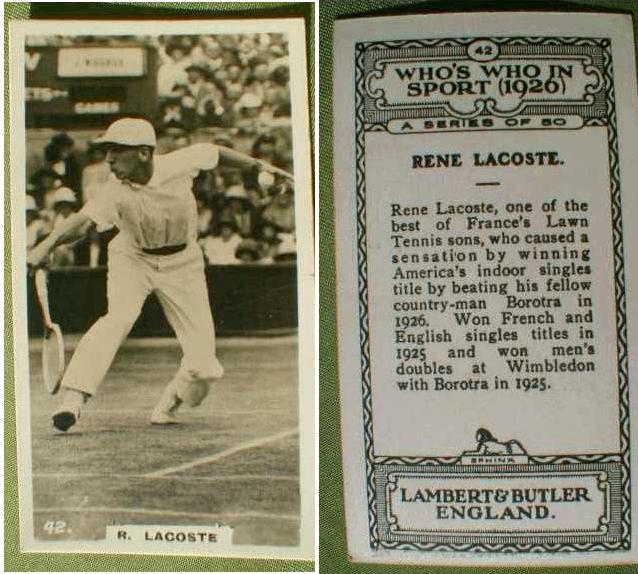 |
| Enlargement of an image
of a packet of English ‘Lambert & Butler’ cigarettes, 1926.
The photograph was taken at Wimbledon, probably during his final against Borotra in 1925. For once, Lacoste is not wearing his famous golfer’s cap. This card is after René Lacoste’s victory at the American indoors championships in february 1926. |
 E-mail
E-mail
Dernière mise à jour : 24
Mai 2000
Copyright BLANCHE NET communications.
Mars 2000.